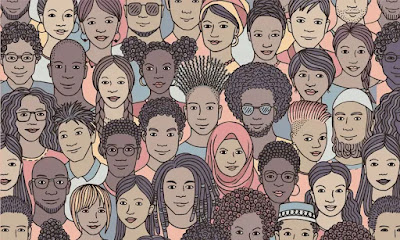bell hooks & Fiction
“A place of healing” can mean many different things, but I will be evaluating how fiction can serve those affected by trauma. As Michelle Balaev defines in Mosaic, “Trauma, in my analysis, refers to a person's emotional response to an overwhelming event that disrupts previous ideas of an individual's sense of self and the standards by which one evaluates society.” This is the definition I will be referring to when I mention trauma. In consideration of this, it is no surprise that the emotional intensity of trauma demands the radical care of fiction.Trauma is especially present in Toni Morrison’s only short story, “Recitatif” (Treisman). It is striking that Morrison never explicitly laid out the racial identities of the two protagonists in “Recitatif” in a time when American society deemed them as particularly critical to their overall identities (Joseph). Depicting her characters independently of their racial identities — while observing all the ways in which they are affected by those parts of their identity — was something that could have only been achieved through writing fiction.
To elaborate, in late 1950s - 1970s America, race was a critical part of one’s identity and often the first thing that people thought about when first perceiving others (Joseph). It still is, even though the fact that it is one of the first things that people notice about a person is not inherently wrong or racist; it is the weight of the interpretation of this “taking in” where the problem lies because of the stereotypes that sometimes come with it. Thus, by deliberately omitting the characters’ race, as Morrison states in an interview about “Recitatif,” the audience has no other choice than to see them as human. The reader must think critically about their identities now. Through omitting the racial identities of her characters, Morrison was able to create a world in which her readers could imagine a world in which the core identities of the protagonists, and their consequent reactions to the changing tides about the relationship between Blacks and Whites between when they first meet and when the story leaves off, are singly evaluated.
Studies have shown that racism is learned, not something that people are born with (Peek). In the United States, it has been reinforced through a legacy of segregation and discrimination, so that many have great difficulty distinguishing one’s race and character (Peek). This is how Morrison’s “Recitatif” serves as a healing space for those who have been harmed by this societal tendency, while providing a space for everyone to better imagine a path out of a world that is still plagued with racial injustice.However, there is a range with which fiction can be a place of healing — some pieces of fiction will innately be more healing to readers than others. bell hooks argues that feminist transformation — and by extension, personal transformation — can only be achieved through a critical examination of one’s “personal experience” and their consequent “personal testimony” on it. Thus, because fiction is fundamentally built on one’s experiences (this pertains to the author) and the perception they develop of the world in response to those experiences (this pertains to the reader), fiction can be a mechanism for personal transformation, in addition to healing (although they are not mutually exclusive) when the reader becomes as equally willing to grow from the fiction they consume as the author is in writing it.
Works Cited
“‘A Failure of the Imagination’? The Fiction Vs. Nonfiction Debate on JSTOR.” www.jstor.org. JSTOR, www.jstor.org/stable/41957300?searchText=nonfiction+over+fiction&searchUri=%2Faction%2FdoBasicSearch%3FQuery%3Dnonfiction%2Bover%2Bfiction&ab_segments=0%2Fbasic_search_gsv2%2Fcontrol&refreqid=fastly-default%3Ad9d0d37ba1bbef6742127b74da5992b7&seq=1.
“Beyond ‘Healing’: Trauma, Oral History and Regeneration on JSTOR.” www.jstor.org. JSTOR, www.jstor.org/stable/40179842?searchText=sean+field&searchUri=%2Faction%2FdoBasicSearch%3FQuery%3Dsean%2Bfield&ab_segments=0%2Fbasic_search_gsv2%2Fcontrol&refreqid=fastly-default%3Abdb8a9325f774bb97d9d2b6636e2f078.
“The Black Power Movement: A State of the Field on JSTOR.” www.jstor.org. JSTOR, www.jstor.org/stable/25622477?searchText=race+in+1960s+america&searchUri=%2Faction%2FdoBasicSearch%3FQuery%3Drace%2Bin%2B1960s%2Bamerica&ab_segments=0%2Fbasic_search_gsv2%2Fcontrol&refreqid=fastly-default%3Af14172e0ec56e91ec8f35b615112e652.
Hooks, Bell. “Theory as Liberatory Practice.” Yale Journal of Law and Feminism, openyls.law.yale.edu/bitstream/handle/20.500.13051/7151/05_4YaleJL_Feminism1_1991_1992_.pdf?sequence=2&isAllowed=y.
Morrison, Toni. Recitatif. Random House, 2022.
Peek, Monica E., et al. “Practical Lessons for Teaching About Race and Racism: Successfully Leading Free, Frank, and Fearless Discussions.” Academic Medicine, vol. 95, no. 12S, Nov. 2020, pp. S139–44, doi:10.1097/acm.0000000000003710.
Treisman, Rachel. “Toni Morrison’s Only Short Story Is Available in Book Form for the First Time.” NPR, 1 Feb. 2022, www.npr.org/2022/02/01/1077198351/recitatif-toni-morrison-short-story#:~:text=Toni%20Morrison%20%E2%80%94%20the%20late%20author,short%20story%3A%20%22Recitatif.%22.
“Trends in Literary Trauma Theory on JSTOR.” www.jstor.org. JSTOR, www.jstor.org/stable/44029500?searchText=trauma&searchUri=%2Faction%2FdoBasicSearch%3FQuery%3Dtrauma&ab_segments=0%2Fbasic_search_gsv2%2Fcontrol&refreqid=fastly-default%3Af488bbcbd898960a41805b448d610cd2&seq=2.








Comments
Post a Comment